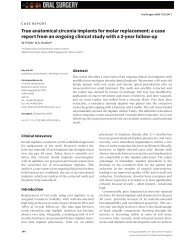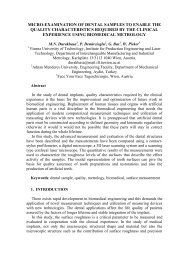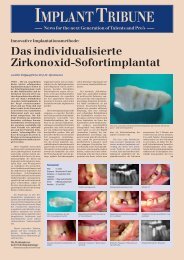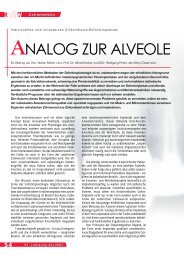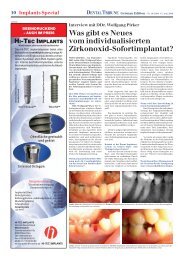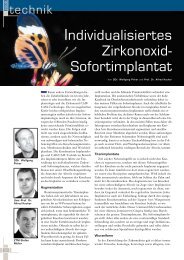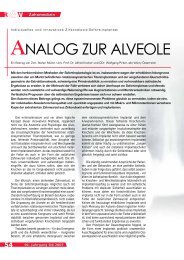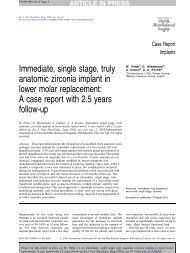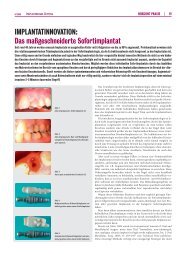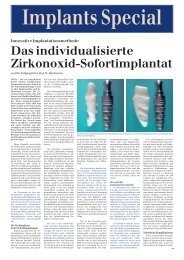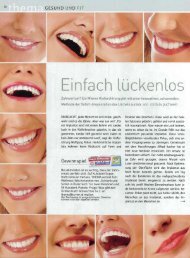implants
You also want an ePaper? Increase the reach of your titles
YUMPU automatically turns print PDFs into web optimized ePapers that Google loves.
I case _ report<br />
14 I<br />
<strong>implants</strong><br />
4_2009<br />
the surface it is important to prepare the implant site<br />
in an atraumatic way and to achieve a perfect bone to<br />
implant contact.<br />
There is absolutely no logical reason at all not to<br />
use the already existing intact tooth socket as implant<br />
site and to adapt the implant to the tooth socket instead<br />
of the vice versa approach including drilling,<br />
bone trauma, bone loss and additional bone augmentations.<br />
All attempts in the long history of dental science to<br />
fix homologue, heterologue or allogeneic root analogue<br />
<strong>implants</strong> into a fresh extraction socket failed<br />
due to the conical root form, rejection and lack of preciseness<br />
and were therefore not established. With the<br />
implementation of the modern CAD/CAM technology<br />
it became easily possible to manufacture an exact<br />
copy of the dental root.<br />
_“Differentiated Osseointegration”<br />
The fundamental advantage of this innovative implant<br />
system is not only the reconstruction of the<br />
anatomy of the individual tooth, but also the fact, that<br />
it is possible to consider the underlying bone quantity<br />
and quality. This way the surface of the implant can<br />
be modified accordingly. Macro-retentions (protrusions)<br />
are a conditio sine qua non for the safe fixation<br />
of a root-formed and therefore conical implant in the<br />
bone. Macro-retentions have to be strictly limited to<br />
spongy bone, since only spongy bone can absorb pressure<br />
without fracture at a remote site. Micro fractures<br />
cannot be avoided, but in contrast to fractures of cortical<br />
bone fractures in spongy bone remain limited<br />
with reduced damage and quick regeneration due to<br />
the excellent blood supply always present in spongy<br />
bone.<br />
Another reason for the high regenerative potential<br />
of spongy bone lies in its extensive vascularization. Retentions<br />
in the area of the thin cortical bone leads irrevocably<br />
to fractures, sometimes at remote sites, with<br />
subsequent bone recession. In order to be on the safe<br />
side and avoid fracture of the thin cortical bone at any<br />
cost, the implant is reduced at the buccal and lingual<br />
face by approximately 0.1–0.2mm. The principle of<br />
differentiated osseointegration therefore dictates the<br />
innovative implant design. In areas without macro retentions<br />
no fracture or impression induced resorption<br />
takes place and primary osseointegration occurs<br />
without delay. Only by consideration of these different<br />
healing modalities osseointegration can be accomplished<br />
in conical or root-analogue formed <strong>implants</strong>.<br />
_Advantages of the novel method<br />
No bone drilling and drilling guides are necessary.<br />
Associated risks are avoided.<br />
No bone drilling equals no operative trauma, no<br />
bone loss, no damage to neighboring structures including<br />
dental roots, mandible nerve, or maxillary sinus.<br />
The exact fit of the implant leads to an optimized<br />
implant-bone contact surface and thus maximal primary<br />
stability with shorter healing periods, because<br />
there are no gaps between the implant and the bone.<br />
Furthermore additional surgical interventions like<br />
bone augmentation, guided bone or tissue regeneration<br />
are not required. The exclusive use of root colored<br />
Zirconia leads reproducibly and predictably to satisfying<br />
esthetic results. The single piece implant is exposed<br />
to a reduced functional load from the beginning, preventing<br />
bone and soft tissue recession. Absolutely no<br />
secondary prosthetic parts, no specific surgical instruments,<br />
drilling equipments and screw drivers are required.<br />
The single stage implant is put in place by use<br />
of a mallet and a hammer. Absolute no tool kit is necessary<br />
and no special knowledge about the confusing<br />
and highly company specific numerous secondary<br />
implant parts and there individual names is required.<br />
The crown stump can be adapted by means of grinding<br />
at any time by use of conventional dental equipment.<br />
_Disadvantages<br />
At the present time patients with damaged periodontal<br />
ligament are excluded (careful extraction is<br />
mandatory)<br />
Currently only single stage <strong>implants</strong> are available.<br />
Position of misaligned tooth cannot be corrected.<br />
Method in its infancy, further studies are necessary.<br />
Dental implant is not yet on the market available.<br />
This case, which is part of a larger ongoing clinical<br />
trial, demonstrates that immediate placement of significantly<br />
modified, root-analogue, non-submerged<br />
Zirconia <strong>implants</strong> yields excellent results superior to<br />
previously described custom made root-analogue titanium<br />
<strong>implants</strong> with a uniform surface._<br />
The Literature list can be requested from the editorial<br />
office.<br />
_contact<br />
Wolfgang Pirker, MD, DDS<br />
Maxillo-Facial Surgeon<br />
Schulerstraße 1–3/65<br />
1010 Vienna,Austria<br />
Phone: +43-1/5 12-24 00<br />
E-mail: info@face.at<br />
Alfred Kocher, MD<br />
Professor of Surgery<br />
Medical University of Vienna<br />
Währinger Gürtel18–20<br />
1090 Vienna,Austria<br />
Phone: +43-6 64/2 61 85 69<br />
Fax: +43-1/5 12-2 25 28<br />
E-mail:Alfred.Kocher@meduniwien.ac.at<br />
<strong>implants</strong>




